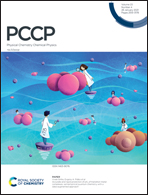Redox-couple investigations in Si-doped Li-rich cathode materials†
Abstract
In this investigation, the improved electrochemical behavior in Si-doped Li-rich cathodes is studied with scanning transmission electron microscopy (STEM) and electron energy loss spectroscopy (EELS). Z-contrast images show a layered structure that develops a thin, spinel-like surface layer after the first charge cycle. Si-doping increases discharge capacity by ∼25% and appears to retard the surface phase transformation. Based on electron energy loss spectra, the surface layer in the doped material has an altered oxygen electronic environment, which supports the STEM findings. Furthermore, Si-doping changes the redox behavior during the activation cycle. Density functional theory calculations indicate that Si-doping can increase oxygen vacancy formation, and change the sequence of the redox couples by introducing more oxygen vacancies before or during the typical high voltage activation process. The results of this work indicate that the type of doping employed here is an effective strategy for controlling the complex charge compensation mechanisms in lithium-rich cathodes.



 Please wait while we load your content...
Please wait while we load your content...